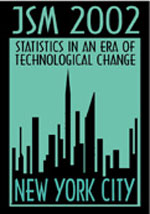|
Activity Number:
|
359
|
|
Type:
|
Contributed
|
|
Date/Time:
|
Wednesday, August 14, 2002 : 2:00 PM to 3:50 PM
|
|
Sponsor:
|
Section on Survey Research Methods*
|
| Abstract - #301978 |
|
Title:
|
Evaluation of a Two-Phase Approach to Segment Selection for Area Probability Samples Late in a Decade
|
|
Author(s):
|
Jill Montaquila*+ and Erica Sherris and Leyla Mohadjer
|
|
Affiliation(s):
|
Westat, Inc. and Westat, Inc. and Westat, Inc.
|
|
Address:
|
1650 Research Blvd., Rockville, MD, 20850, USA
|
|
Keywords:
|
New construction ; measure of size ; double sampling ; decennial census
|
|
Abstract:
|
In an area probability sample, the first stage of selection is generally the primary sampling unit (PSU), and the second stage is the segment. The segments are usually clusters of blocks. Often, PSUs and segments are selected with probabilities proportionate to a measure of size (MOS), based on data from the most recent decennial census. Although the PSU MOS may be updated using more recent estimates, intercensal estimates are not available for areas typically used as segments. To address this issue, a two-phase approach was used for segment selection in the National Health and Nutrition Examination Survey (NHANES) in 2000 and 2001 (prior to the release of Census 2000 data). The two-phase approach uses data on building permits issued to revise the segment MOS at the first phase of selection and select a larger sample segments than is ultimately needed. Listers are sent out to the PSU to estimate the number of dwelling units in each segment sampled in the first phase. For the second phase of segment selection, an updated MOS based on the listers' estimates is used. This paper describes the two-phase approach and evaluates it using data from the NHANES 2000 and 2001 surveys.
|
- The address information is for the authors that have a + after their name.
- Authors who are presenting talks have a * after their name.
Back to the full JSM 2002 program |

